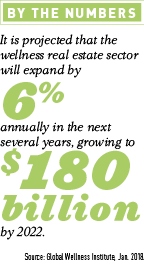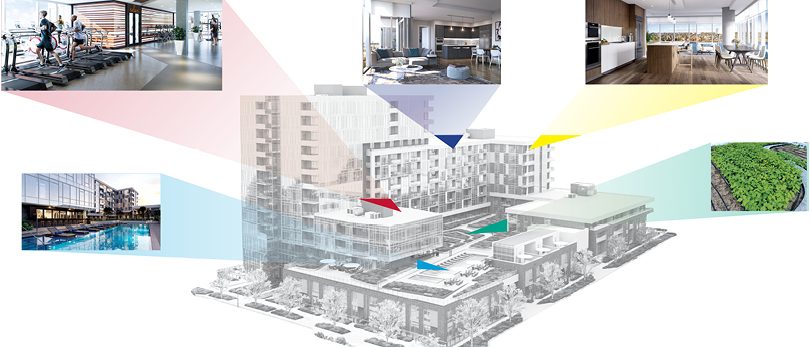Wellness-focused buildings and communities integrate physical and mental health for residents
By Megan Craig
Not long ago, a homebuyer who was focused on wellness searched for a place large enough to fit a stationary bike. But wellness buffs today aren’t just looking for a gym in the building or an outdoor pool. They’re looking for regular yoga classes with a certified instructor, an air circulation system like those used in hospital surgical suites and a rooftop “urban farm” where organic vegetables are grown for the entire community. These buyers want physical wellness, but now they’re also looking for homes that focus on a full mind-body health experience—right in their building or neighborhood.
Welcome to “wellness living,” a real estate trend about to take off across the country.
What is wellness living?
Wellness-forward homes are designed around the body and mind’s most basic needs. They are built to keep it’s residents as healthy as possible. “In a nutshell, the wellness-living movement means giving people amenities they need to create more of the healthy lifestyle they want,” says Christopher Linsell, a licensed agent in Michigan and real estate analyst for New York-based website theclose.com.
Taking the turn toward natural living from its predecessors (LEED and Green certifications), the WELL Building Standard seeks to make eco-friendly homes more human-friendly. Written about and touted by some of the most influential holistic health experts in the world, WELL focuses on seven key areas:
- Air: Minimizing indoor air pollution with special air filtration systems and mold mitigation.
- Water: Promoting high-quality water systems and improving accessibility to water with hydration and beverage systems.
- Nourishment: Limiting bad foods in the building and increasing access to healthy foods.
- Light: More natural light and lighting systems that mimic natural light, allowing for better mood and sleep patterns.
- Fitness: Integrating physical wellness with wellness center, lap pool and sauna.
- Comfort: Reducing distraction through comfortable indoor spaces.
- Mind: Improving mental health of residents.
For Brian Levitt, president of NAVA Real Estate Development and developer of Lakehouse, the first building in Colorado to pursue the WELL Building Standard, the transition to wellness-focused buildings was natural—everyone in his family works in health care, and he had already pushed the envelope with LEED-certified buildings in the early 2000s. For him, the “very high bar” set by WELL standards wasn’t intimidating; instead, it was a call to action.
“Basically, they reverse-engineered the design of a building to allow for the best health outcomes,” Levitt says. “It’s fun to see this standard that’s all about people, all based on the systems in our body.”
Lakehouse is a 12-story, 196-unit wellness-minded condominium and rowhome development. It includes a MERV-13 building air filtration system, a UV-filtered pool and hot tub, solar and blackout shades (to promote circadian rhythms), a yoga/meditation studio, weekly fitness classes, the use of natural and durable materials, a collaborative kitchen, a professionally-managed urban farm to support “biophilia” (the human connection to nature), a creative workshop for artwork, meditation gardens and more.
“Part of it is in the structure, part of it is in the amenities, part of it is the residents—it’s the marriage of those pieces that will create this health and wellness benefit,” Levitt says.
A “wellness concierge” pulls it all together for residents, helping with scheduling fitness sessions, answering questions and fostering a sense of community through events, classes and educational opportunities. “We’re excited about the fact that WELL is a certification that’s actually about the occupants and how we can benefit their lives long-term,” says Matthew McNeill, associate broker for Kentwood City Properties in Denver, the brokerage selling the condominiums and rowhomes at Lakehouse. “It all comes together in the details.”
Different ways to live well
Not everyone looking for wellness living wants (or can afford) everything involved in a WELL-certified home, and these homes still make up a minuscule portion of properties available on the market today.
But wellness living isn’t reserved for those in explicitly wellness-focused properties. “It’s a conversation you’re having with all your clients to put them in the direction of greener homes, kind of nudging them to say ‘there’s this property that’s greener and healthier,’” says John Oppermann, associate real estate broker and green home specialist with Compass in New York City and executive director of the Earth Day Initiative. “There’s a trend that enables you to pick and choose from greener or healthier building practices, but you don’t get the official seal of certification.”

Source: Global Wellness Institute, Jan. 2018
Agents who aren’t selling WELL-certified homes may still be selling wellness living. Take Rochelle Atlas Maize, executive director of the luxury estate division at Nourmand & Associates in Beverly Hills, California. When a developer gave her the opportunity to design amenities for a new luxury home, she knew she needed to focus those amenities on health.
Atlas Maize called the home, which sold for more than $11 million, the “Wellness House” and geared it toward a wellness-conscious individual. The home’s high-end amenities include a wellness center with a Scandinavian hydrotherapy circuit, a sauna with steam and a yoga/meditation area. The gym includes a mirror that turns into a screen with a virtual personal trainer and a Peloton bike. The developer also gifted the buyer three months’ worth of home-delivered, cold-pressed juices and home visits from a yoga instructor.
“LA is very health-oriented. The buyer was a healthy guy who loved the idea of all these benefits right in the house,” Atlas Maize says.
But it’s not only the uber-rich who are interested in wellness, Linsell says. Even in the more traditional-minded suburban Midwest, some subdivision developers are reserving parcels for community farms, walking paths, green space and meditation gardens: “They’re popping up in standard residential layouts and being rolled into a typical homeowner’s association,” he says.
Marketing through education
So, if all different types of buyers might be interested in wellness living, why isn’t it more popular already? It’s an education issue, Linsell says. “The ‘wellness community’ movement is relatively new in the real estate world. Consequently, most residential agents aren’t privy to all of the healthy living options certain communities can provide,” Linsell says. “So, in order to close deals, agents should educate themselves on the various ‘wellness amenities,’ why they’re valuable and how such conveniences factor into the price of a home.”
But better marketing for wellness living doesn’t end with agent education: “The overall supply of greener, healthier homes isn’t increasing as much as it could because people don’t know to ask for it,” Oppermann says.
To bring your clients in on this trend, Oppermann recommends:
- Making it personal. As with any kind of marketing, your pitch for wellness living has to resonate with the buyer as an individual. Talk with your client about their own wellness interests before launching into a pitch for an amenity that doesn’t matter to your buyer.
- Talking about wellness with every client. Make wellness one of your “top 10 list” items. You wouldn’t hesitate to talk with a client about appliances, location and price, so why wouldn’t you talk with them about wellness features as part of their future in that home?
- Relying on word-of-mouth. People tend to flock to lifestyles similar to those of their friends. By talking with clients about wellness living, you’re encouraging them to talk with other potential buyers in their networks who may be interested as well.
Even in the case of the Lakehouse, McNeill says not every buyer started out looking for wellness living. They were looking for a great location, walkability and views—and the building’s location next to a large park led naturally to conversations about air quality and biophilia. Over the summer, the group even teamed up with area wellness experts and fitness studios to hold its first-ever “fitness series” in the 177-acre Sloan’s Lake Park, which is just steps from Lakehouse.
“People really want to create healthier environments for themselves and their families, so talking about various things you can do to make a healthier space in your home should be natural,” Oppermann says.
A special kind of buyer?
Right now, wellness amenities are most common in high-end homes and communities, which may mean they’re not as available to average purchasers. But there is no typical wellness-living buyer.
“That’s because people in all walks of life are concerned about the healthfulness and safety of the spaces in which they live,” says John Oppermann, associate real estate broker and green home specialist with Compass in New York City and executive director of the Earth Day Initiative.
“Think of young parents who live in the city—they obsess about good food and nontoxic toys, but they may not even think about the fact that their kids are crawling around on a floor that contains formaldehyde,” Oppermann says. “They might want to avoid that if they knew it was there.”
Because of the mostly higher cost of these amenities right now, many first-time homebuyers may be unable to afford the price tag. But that will change as developers see more reasons to integrate wellness into the properties they build and remodel.
“Developers are placing bets on whether or not these kinds of amenities are going to be successful, and agents play a key role in determining that success,” says Christopher Linsell, a licensed agent in Michigan and real estate analyst for New York-based website theclose.com. “It’s really up to us to be able to demonstrate why these amenities are so valuable.”
Learn more about WELL certification for improving health through design.








